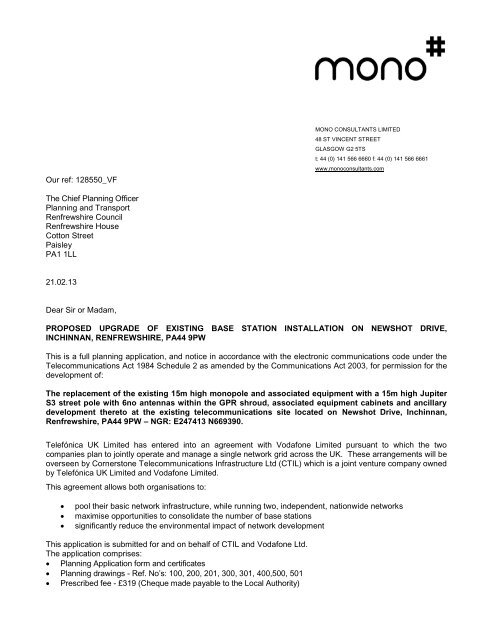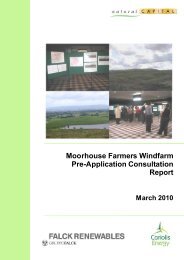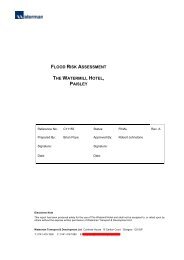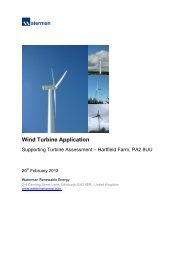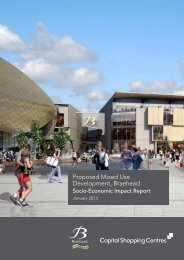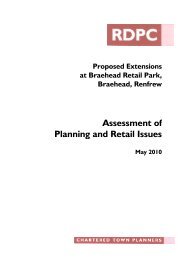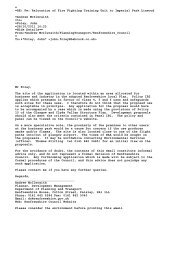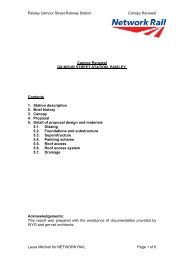Supporting documents - Renfrewshire Council
Supporting documents - Renfrewshire Council
Supporting documents - Renfrewshire Council
Create successful ePaper yourself
Turn your PDF publications into a flip-book with our unique Google optimized e-Paper software.
Our ref: 128550_VF<br />
The Chief Planning Officer<br />
Planning and Transport<br />
<strong>Renfrewshire</strong> <strong>Council</strong><br />
<strong>Renfrewshire</strong> House<br />
Cotton Street<br />
Paisley<br />
PA1 1LL<br />
21.02.13<br />
Dear Sir or Madam,<br />
MONO CONSULTANTS LIMITED<br />
48 ST VINCENT STREET<br />
GLASGOW G2 5TS<br />
t: 44 (0) 141 566 6660 f: 44 (0) 141 566 6661<br />
www.monoconsultants.com<br />
PROPOSED UPGRADE OF EXISTING BASE STATION INSTALLATION ON NEWSHOT DRIVE,<br />
INCHINNAN, RENFREWSHIRE, PA44 9PW<br />
This is a full planning application, and notice in accordance with the electronic communications code under the<br />
Telecommunications Act 1984 Schedule 2 as amended by the Communications Act 2003, for permission for the<br />
development of:<br />
The replacement of the existing 15m high monopole and associated equipment with a 15m high Jupiter<br />
S3 street pole with 6no antennas within the GPR shroud, associated equipment cabinets and ancillary<br />
development thereto at the existing telecommunications site located on Newshot Drive, Inchinnan,<br />
<strong>Renfrewshire</strong>, PA44 9PW – NGR: E247413 N669390.<br />
Telefónica UK Limited has entered into an agreement with Vodafone Limited pursuant to which the two<br />
companies plan to jointly operate and manage a single network grid across the UK. These arrangements will be<br />
overseen by Cornerstone Telecommunications Infrastructure Ltd (CTIL) which is a joint venture company owned<br />
by Telefónica UK Limited and Vodafone Limited.<br />
This agreement allows both organisations to:<br />
pool their basic network infrastructure, while running two, independent, nationwide networks<br />
maximise opportunities to consolidate the number of base stations<br />
significantly reduce the environmental impact of network development<br />
This application is submitted for and on behalf of CTIL and Vodafone Ltd.<br />
The application comprises:<br />
Planning Application form and certificates<br />
Planning drawings - Ref. No’s: 100, 200, 201, 300, 301, 400,500, 501<br />
Prescribed fee - £319 (Cheque made payable to the Local Authority)
General Background Information for Telecommunications Development<br />
Site Specific Supplementary Information<br />
ICNIRP declaration & clarification statement<br />
This application has been prepared in accordance with the industry Ten Commitments to Best Siting Practice.<br />
The proposal subject of the enclosed application is identified as the most suitable site option and design that<br />
balances operational need with local planning policies and national planning policy guidance.<br />
Furthermore we would like to assist the council and would like to arrange a presentation or meeting with your<br />
officers and members to discuss the issues if appropriate.<br />
We are committed to maintaining a positive relationship with all Local Planning Authorities and we would be<br />
happy to provide any additional information in relation to this application.<br />
We look forward to receiving your acknowledgement and decision in due course.<br />
Yours faithfully<br />
Ginny Hall MRTPI<br />
PLANNER<br />
Email: ginny.hall@monoconsultants.com<br />
Direct Dial: 0141 270 2733<br />
Mobile: 07796 995 843<br />
(for and on behalf of CTIL and Vodafone Ltd)
SUPPLEMENTARY INFORMATION<br />
1. Site Details<br />
Site Name: Freeland Site Address: Newshot Drive<br />
NGR: E247413, N669390<br />
Inchinnan<br />
<strong>Renfrewshire</strong><br />
OA4 9PW<br />
Site Ref Number: (CTIL)128550_(VF)85012 Site Type: 1 Upgrade<br />
2. Pre Application Check List<br />
Site Selection<br />
Was an LPA mast register used to check for suitable sites by the operator or the<br />
LPA?<br />
If no explain why:<br />
No mast register available.<br />
Yes No<br />
Was the industry site database checked for suitable sites by the operator: Yes No<br />
If no explain why:<br />
n/a<br />
Annual roll out consultation with LPA<br />
Date of last annual rollout information/submission: October 2012<br />
Name of Contact: Head of Planning<br />
Summary of outcome/Main issues raised: No issues raised to date.<br />
Pre-application consultation with LPA<br />
Date of written offer of pre-application consultation: 21/01/13<br />
Was there pre-application contact: Yes No<br />
Date of pre-application contact: N/A<br />
Name of contact: Director of Planning<br />
Summary of outcome/Main issues raised:<br />
A pre-application letter of consultation was sent to the Local Planning Authority seeking their views on the<br />
operator’s proposal to upgrade a number of existing base stations within the authority.<br />
To date, we have not received any response.<br />
In light of the above, when balanced against the nature of the upgrade development and matters which would<br />
be considered by the LPA in the planning process, it was considered appropriate to proceed with the<br />
submission of this application.<br />
Ten Commitments Consultation<br />
Rating of Site under Traffic Light Model: Green Amber Red<br />
Outline Consultation carried out:<br />
A pre-application letter of consultation was sent to all <strong>Council</strong>lors seeking their views on the operator’s proposal<br />
to upgrade a number of existing base stations within the authority.<br />
1 Macro or Micro
Summary of outcome/Main issues raised:<br />
To date, we have not received any response.<br />
School/College<br />
Location of site in relation to school/college:<br />
No schools or colleges were considered to have a direct or functional relationship with the site.<br />
Outline of consultation carried out with school/college:<br />
n/a<br />
Summary of outcome/Main issues raised:<br />
n/a<br />
Civil Aviation Authority/Secretary of State for Defence/Aerodrome Operator consultation (only required<br />
for an application for prior approval)<br />
Will the structure be within 3km of an aerodrome or airfield? – n/a Yes No<br />
Has the Civil Aviation Authority/Secretary of State for Defence/Aerodrome Operator<br />
been notified? – n/a<br />
Details of response:<br />
n/a<br />
Yes No<br />
Developer’s Notice<br />
Copy of Developer’s Notice enclosed? – n/a Yes No<br />
Date served: n/a<br />
3. Proposed Development<br />
The proposed site:<br />
The existing telecommunications site, to which this application relates, is located on Newshot Drive, Inchinnan,<br />
<strong>Renfrewshire</strong>, PA44 9PW.<br />
Enclose map showing the cell centre and adjoining cells:<br />
Coverage plots showing how the site fits into the surrounding network are available on request.<br />
Type of Structure<br />
Description:<br />
The replacement of the existing 15m high monopole and associated equipment with a 15m high Jupiter S3<br />
street pole with 6no antennas within the GPR shroud, associated equipment cabinets and ancillary development<br />
thereto.<br />
Overall Height:<br />
Height of existing building (where applicable): n/a metres<br />
Equipment Housing: Huawei<br />
Length: 0.600metres<br />
Width: 0.450metres<br />
Height: 1.600metres
Materials (as applicable):<br />
Tower/mast etc – type of material and external colour: Jupiter S3 - Grey<br />
Equipment housing – type of material and external RAL7035<br />
colour:<br />
Reasons for choice of design:<br />
Telefónica UK Limited, commonly known as O2 and Vodafone Limited are have a common interest in providing<br />
coverage from the same site through the use of a single base station. As part of a sequential approach to site<br />
selection an existing base station made available as part of the aforementioned operators exclusive initiative<br />
was identified. However the installation in its current form does not meet the operator’s technical requirements,<br />
hence the existing base station requires upgrading and redevelopment. The current design, colours and<br />
antenna heights of the existing installation has influenced the choice of design for the upgrade proposal which is<br />
subject of this application.<br />
The aim of this phase of the project is to align the Telefónica and Vodafone networks where best possible. The<br />
long term objective of this will be to reduce the total number of base stations nationally as sites will be<br />
consolidated for single base stations that work for both operators. The choice of design pursued offers a<br />
technically preferred solution, which allows for the antennas to be titled and orientated so as to provide cell<br />
specific coverage to meet the specific demands of the target area. The height pursued will improve the<br />
coverage footprint and help maintain reliable capacity from this site. This proposal will enable network<br />
restructuring that will aid single grid improvements to address existing and future demands for mobile coverage.<br />
4. Technical Information<br />
ICNIRP Declaration attached<br />
ICNIRP public compliance is determined by mathematical calculation and implemented<br />
by careful location of antennas, access restrictions and/or barriers and signage as<br />
necessary. Members of the public cannot unknowingly enter areas close to the<br />
antennas where exposure may exceed the relevant guidelines.<br />
When determining compliance the emissions from all mobile phone network operators<br />
on the site are taken into account.<br />
Yes No<br />
Frequency: 1800 & 2100 MHz<br />
Modulation characteristics 2 GSM & UMTS<br />
Power output (expressed in EIRP in dBW per carrier)<br />
Maximum 32 dBW<br />
In order to minimise interference within its own network and with other radio<br />
networks, Vodafone Limited operates its network in such a way the radio<br />
frequency power outputs are kept to the lowest levels commensurate with<br />
effective service provision<br />
As part of Vodafone Limited’s network, the radio base station that is the subject<br />
of this application will be configured to operate in this way.<br />
All operators of radio transmitters are under a legal obligation to operate those<br />
transmitters in accordance with the conditions of their licence. Operation of the<br />
transmitter in accordance with the conditions of the licence fulfils the legal<br />
obligations in respect of interference to other radio systems, other electrical<br />
equipment, instrumentation or air traffic systems. The conditions of the licence<br />
are mandated by Ofcom, an agency of national government, who are<br />
2<br />
The modulation method employed in GSM is GMSK (Gaussian Minimum Shift Keying) which is a form of Phase<br />
modulation<br />
The modulation method employed in UMTS is QPSK (Quad Phase Shift Keying) which is another form of Phase<br />
Modulation
esponsible for the regulation of the civilian radio spectrum. The remit of Ofcom<br />
also includes investigation and remedy of any reported significant interference.<br />
The telecommunications infrastructure the subject of this application accords<br />
with all relevant legislation and as such will not cause significant and<br />
irremediable interference with other electrical equipment, air traffic services or<br />
instrumentation operated in the national interest.<br />
Height of antenna (m above ground level) 12m & 13.5m<br />
5. Technical Justification<br />
Enclose predictive coverage plots.<br />
Reason(s) why site required e.g. coverage, upgrade, capacity (map attached if required):<br />
Telefónica, commonly known as O2 and Vodafone have recently announced their plan to jointly operate and<br />
manage a single network grid in the UK. This groundbreaking initiative strengthens the network infrastructure<br />
partnership between the two companies, previously rolled out as part of ‘Cornerstone’ as it moves beyond<br />
simple mast sharing.<br />
Due to the dramatic rise in the use of mobile data, the industry has had to consider new operating models that<br />
are efficient at delivering 3G and 4G services to a much larger percentage of the UK’s population. Both<br />
companies will pool their basic network infrastructure, while running two, independent, nationwide networks. By<br />
doing this, they will both reach far more of the country far faster than they could achieve on their own. This<br />
single network grid will automatically increase each operator’s footprint by 40%, adding competition and choice<br />
for customers in areas that previously only had one operator’s coverage available. Each operator will keep<br />
ownership and control of its network spectrum. This means each will have responsibility for the management<br />
and maintenance of the grid in one half of the UK. Telefónica will manage and maintain the network in the East<br />
whilst Vodafone will be responsible for those sites in the West.<br />
Both companies pledge to close the digital divide between rural and urban areas targeting 98% indoor<br />
population coverage across 2G and 3G by 2015. That compares with about two-thirds of the country that<br />
currently receives indoor 3G coverage from either network today. This agreement will also lay the foundations<br />
for two competing 4G networks to deliver the capability for a nationwide 4G service faster than could be<br />
achieved independently. The pooling together of the networks could also mean a reduction in the number of<br />
sites in the UK from the two operators, so there would be environmental benefits too. They will also be able to<br />
build new sites in areas which neither company has been able to reach on its own. From a customer<br />
perspective they won’t see any change as customers will continue to use each operator’s network. This<br />
agreement is about consolidating infrastructure assets, clearing the way for innovation and the creation of new<br />
services that customers demand.<br />
Telefónica and Vodafone are both Electronic Communications Code Systems Operators licensed under the<br />
terms the Communications Act 2003 to provide mobile personal communications networks in the UK. In order<br />
to improve the level of service they provide for their customers in line with its licence requirements, both<br />
companies are constantly developing their networks, as well as refining and modernising their equipment.<br />
Given the dynamic nature of technological advances in telecommunications products, coupled with the<br />
demands on operators from subscribers to provide new and better quality services, this dictates a continual<br />
reinvestment programme in the infrastructure behind the use of mobile devices. Operators are currently<br />
involved in developing sites to provide coverage to areas which have not benefited from access to the full<br />
services they offer and to areas of their existing network where increased capacity or improved service quality is<br />
required.<br />
Many more people now use mobile devices for personal and business purposes and to a large proportion of the<br />
UK population; the use of a mobile phone is now considered an essential part of everyday lives, both at work<br />
and in their leisure time. These customers legitimately demand and expect to have adequate signal coverage<br />
and capacity for their mobile devices throughout the country. However it remains the case in some areas and at<br />
particular times of the day, capacity on mobile networks may not keep up with demand, creating network<br />
congestion, poor download speeds and service disconnections. Combating these technical deficiencies are at<br />
the forefront of the origins of a new search cell instruction and the need to upgrade existing base station sites in
an operator’s network.<br />
According to the Mobile Operator’s Association there are now 81.6 million mobile connections in the UK. With<br />
regards the basic functionality of mobile phones the MOA suggest that mobile consumers in the UK sent over<br />
150 billion texts in 2011 with the average person believed to send 50 texts a week. Although the main<br />
functionality of mobile phones to support voice calls and messaging remains at its core, in recent years the<br />
emergence of smart phones and high-spec wireless devices has put added pressures on operators networks as<br />
customers demand reliable data streaming and coverage capacity. The increased ownership of smart phones<br />
is driving significant increases in the number of people accessing the internet on mobile phone networks,<br />
creating the emergence and growth of the ‘pocket internet’. The MOA highlight that the average time spent<br />
using mobile data services was 2.1 hours a month in 2011, while the volume of data consumed more than<br />
doubled in the 18 months to January 2012. As data volumes over mobile networks has increased this demand<br />
has put significant strain on the operator’s existing networks infrastructure and thus the need for more base<br />
stations. Ofcom have reported that over a quarter of the population in the UK said they have a smart phone,<br />
more than double the number two years ago. In this respect many consumers have commented that typical<br />
mobile speeds and usage caps are insufficient for the use of data-hungry mobile devices seeking to download<br />
music, video content and applications. Internet-based communications services such as social networking sites<br />
and instant messaging has put added pressure on mobile phone networks as the growth in the average time<br />
spent online can be attributed to the use of the internet becoming more mainstream and accessible via mobile<br />
devices.<br />
The MOA reports that; “Mobile telecommunications are vital for the UK’s economic competitiveness and in<br />
promoting social inclusion. There are now over 81.6 million mobile subscriptions in the UK. Over 5.1 million<br />
people now access mobile broadband services via a laptop and dongle, and 39 per cent of UK adults use their<br />
mobile phone for internet access.”<br />
At the end of 2011 the Mobile Operators Association reported that 15% of adults live in a home that has a<br />
mobile phone but no landline. In-building coverage and capacity is therefore a key objective of the operators<br />
infrastructure rollout and upgrade, however given the very nature of mobile devices which can be taken and<br />
used wherever they are needed, this has resulted in the need for high threshold levels of 3G coverage to<br />
provide this indoor service to its customers.<br />
In light of the above it is emphasised that the only reason an operator seeks to place a base station anywhere is<br />
to improve the service to its customers. It would not be financially viable for operators to develop their existing<br />
networks further and invest time and monies into any particular case if there was no demand for the mobile<br />
phone service it seeks to provide. Given people’s expectations that their mobile devices will function 24-7,<br />
when and wherever they need them, it should not be taken for granted that there is a robust telecommunication<br />
infrastructure behind their use. New base stations are required as each cell can only support a finite number of<br />
users at any one time. If there is a high customer demand in a cell then greater capacity is required. Therefore<br />
a base station’s contribution within the operator’s network should be seen as an important economic driver and<br />
material planning consideration.<br />
Further detail regarding the general operation of the Telefónica and Vodafone networks can be found in the<br />
accompanying document entitled ‘General Background Information for Telecommunications Development’. This<br />
information is provided to assist the local planning authority in understanding any technical constraints on the<br />
location of the proposed development.<br />
6. Site Selection Process – alternative sites considered and not chosen<br />
If no alternative site options have been investigated, please explain why:<br />
In accordance with the operator’s licence obligations, SPP and PAN62, a review has been made of existing<br />
telecommunications provision operated by Telefónica and Vodafone within the authority. In accordance with the<br />
sequential approach to site selection, an existing base station in their portfolio has been identified to be<br />
upgraded thereby negating the need for a new base station.<br />
Additional relevant information:
The Planning Act requires that applications be determined in line with the Development Plan unless material<br />
considerations indicate otherwise. The development plan for the proposal and site location is:<br />
<strong>Renfrewshire</strong> Local Plan<br />
“POLICY Tel 1: Assessment of Proposals for Telecommunications<br />
Development<br />
The <strong>Council</strong> will require proposals for telecommunications developments to comply with the <strong>Council</strong>’s approved<br />
policy framework for assessment of planning applications for installation of telecommunications apparatus. The<br />
framework is reproduced in PANEL Tel 1.<br />
PANEL Tel 1: Policy Framework for Assessment of Planning Applications<br />
for Installation of Telecommunications Apparatus.<br />
A. Ground Based Masts:<br />
Within both urban and rural areas, ground based masts should be located to minimise the contrast between the<br />
structure and ancillary equipment and the setting or background.<br />
i. Industrial Areas<br />
Within industrial areas lattice-style masts will generally be considered acceptable, and mast sharing will be<br />
encouraged where possible. The overall height of individual masts will be considered in relation to the height of<br />
existing structures or buildings in the vicinity and any natural screening or landscaping which may be available.<br />
ii. Commercial Areas<br />
Within commercial areas streetworks installations of the monopole type will be generally considered acceptable.<br />
Such masts should ideally be viewed against an existing backdrop or screened by existing trees or buildings<br />
where possible. Equipment housing should be kept to the minimum size necessary, should be located<br />
immediately adjacent to the mast and screened where possible.<br />
iii. Residential Areas<br />
Within residential areas streetworks installations of the monopole type will generally be considered acceptable.<br />
Where possible, monopoles should be viewed against an appropriate back drop and should not be positioned<br />
directly facing the main frontage of residential properties.<br />
iv. Conservation Areas and Affecting the Setting of Listed Buildings<br />
Within Conservation Areas and affecting the setting of listed buildings lattice-style masts will not generally be<br />
considered acceptable. Monopole masts of an appropriate design and height will be considered acceptable<br />
within conservation areas and where they affect the setting of listed buildings if they are viewed against an<br />
appropriate backdrop and do not detract from the townscape qualities of the conservation area, or detract from<br />
the character of the listed building.<br />
v. Rural Areas<br />
Within rural areas ground based masts should be located to take account of natural landscape features, or be<br />
located adjacent to, or within groups of existing trees. Mast sharing will be encouraged where possible, although<br />
any resultant increase in height of the mast will be considered on its merits. The mast design shall take account<br />
of its setting and should be painted, where relevant, to blend with its backdrop.<br />
B. Installation of Equipment on Buildings:<br />
i. Within industrial and commercial areas and on high rise residential properties the installation of equipment on<br />
buildings will generally be considered acceptable, and site sharing will be encouraged where possible.<br />
Antennae should generally be pole mounted to the side of buildings and painted to match the building’s exterior,<br />
equipment housing should be kept to the minimum size necessary and located within the building or on hidden<br />
elevations. Otherwise equipment should be grouped together on the rooftop of the building and screened where<br />
possible by existing features on the roof of the building. The total number permitted will be dependent on the<br />
building’s height and location, and whether it is possible to screen the antennae with existing features.<br />
ii. The installation of stub masts on the roof tops of buildings will not generally be considered acceptable in<br />
commercial or mixed commercial and residential areas, but may be acceptable in industrial areas dependent<br />
upon the height and location of the building on which they will be installed.<br />
iii. The installation of antennae on buildings within a conservation area will not generally be acceptable except<br />
where they can be wholly hidden from public view, or can be disguised as an architectural feature of the<br />
building.<br />
iv. The installation of antennae to the exterior of listed buildings will only be considered in exceptional<br />
circumstances where the antennae are wholly concealed or disguised as part of the building and do not detract<br />
from the character of the building. Equipment housing should ideally be located within the building and should<br />
not detract from the character of the building. Generally, the installation of antennae and equipment housing
within a listed building will be considered acceptable where it is demonstrated that there will be no adverse<br />
impact to the appearance or character of the building.”<br />
In accordance with Policy Tel 1, a review was made of existing telecommunications provision operated by<br />
Telefónica and Vodafone within the authority. In accordance with the sequential approach to site selection, an<br />
existing base station in their portfolio has been identified to be upgraded thereby negating the need for a new<br />
base station. A set of Coverage plots showing how the site fits into the surrounding network are available on<br />
request. It is considered that this minor upgrade of will have no significant impact on surrounding visual amenity.<br />
Overall, it is considered that the proposal subject of this application complies with all the requirements of<br />
Policies.<br />
From the outset, it should be appreciated that irrespective of the installation’s use as a telecommunications<br />
base station, its presence within the public realm will always be, to some degree, noticeable to those local<br />
residents and regular passersby. However it should be recognised that visibility or indeed a development’s<br />
siting and appearance within a particular setting does not automatically result in an overwhelming adverse<br />
harm. It should be acknowledged that the existing base station is now established on-site and the principle of<br />
telecommunication development was considered acceptable when the existing scheme was approved.<br />
Therefore, it is considered that this upgrade application should concentrate on whether the proposed changes<br />
are significant when assessed against any material planning changes in terms of the development’s siting and<br />
surroundings, as well as its up to date planning policy context.<br />
With regards the location of the existing base station and its surrounding characteristics, it is considered that<br />
this locality remains a suitable context for the upgraded telecommunications installation. Taking into account<br />
the development’s siting and appearance when read in its current environment, it is considered that the changes<br />
proposed as part of this upgrade scheme will not be so significant to undermine the visual amenity of the area.<br />
It should be recognised that it is the technical requirements of the telecommunications operator that dictate the<br />
height and appearance of some proposed installations, especially when a structure is shared by more than one<br />
operator.<br />
SPP and PAN 62<br />
The proposal should also be assessed in relation to guidance contained within national planning policy guidance<br />
i.e. the new SPP and Planning Advice Note; PAN 62: Radio Telecommunications which confirms the Scottish<br />
Executive’s intention to secure a world class telecommunications service in Scotland, whilst safeguarding the<br />
environment.<br />
The new SPP is a simplified version of its predecessor NPPG19 although carries through the same themes. It<br />
reiterates the series of options (discussed below) and also stresses that:<br />
“Planning authorities should support the expansion of the electronic communications network, including<br />
telecommunications, broadband and digital infrastructure, through the development plan and development<br />
management decisions, taking into account the economic and social implications of not having full coverage or<br />
capacity in an area. The Government's objective is to ensure that everyone can enjoy the same degree of<br />
access to high quality electronic communication opportunities. This should be achieved in a way that keeps the<br />
environmental impact of communications infrastructure to a minimum.”<br />
PAN62 supports the sensitive siting of telecommunications equipment in both rural and urban areas as a way of<br />
allaying public concerns to this type of development. A good deal of advice is given with respect to the siting<br />
and design of installations and the minimisation of the contrast between telecommunications equipment and its<br />
surroundings in paragraphs 32-33. Paragraph 32 confirms that contrast should be minimised between the<br />
proposed telecommunications equipment to be installed and people’s expectations of a particular scene.<br />
Paragraph 33 confirms that contrast can be minimised by keeping the shape and design of the installation<br />
simple and minimising the number of separate visual elements.<br />
In accordance with the sequential approach to site selection in PAN62, the proposal involves the upgrading of<br />
an existing and established telecommunications installation.<br />
In consideration of health and safety issues, the new SPP advises that the planning system should not be used
to seek objectives more properly achieved under other legislation. Radiofrequency radiation is controlled under<br />
other legislation and so it is not necessary for the LPAs to treat radiofrequency as a material consideration. To<br />
ensure that known health effects have been address applications should be accompanied with an ICNIRP<br />
Certificate. One such certificate accompanies this application.<br />
Unless other material considerations are given enough weight e.g. technical and operational constraints and the<br />
lack of a more suitable alternative site in the area, then the <strong>Council</strong> must be aware that they would be denying<br />
large areas of their land (and their constituents) access to high quality electronic communications opportunities,<br />
contrary to Government policy. The technical requirements of mobile communication operators such as<br />
Vodafone and O2 are well documented within PAN62 and it is clear that telecommunications development may<br />
not always reflect immediate land uses. PAN62 recognises that it is the technical requirements of the<br />
telecommunications operator that dictate the height and appearance of some proposed installations.<br />
In this instance the minor upgrade of the existing base station will provide high quality electronic<br />
communications to the hundreds of people living, working and passing through the area on a daily basis.<br />
Overall, it is considered that there is no more suitable site or design available in the area which would be<br />
acquirable, which would minimise impact on character and visual amenity while also providing the required level<br />
of coverage to the target area and on that basis, it is considered that the proposal is in accordance with the<br />
requirements of national and local policy and guidance.<br />
Contact Details<br />
Name: (Agent) Mono Consultants Limited Telephone: 0141 566 6660<br />
Operator: Vodafone Limited Fax no: 0141 566 6661<br />
Address: 48 St Vincent St<br />
Glasgow<br />
G2 5TS<br />
Email Address: ghall@monoconsultants.com<br />
Signed: Mono Consultants Limited Date: 21.02.13
Our ref: 128550_VF<br />
The Chief Planning Officer<br />
Planning and Transport<br />
<strong>Renfrewshire</strong> <strong>Council</strong><br />
<strong>Renfrewshire</strong> House<br />
Cotton Street<br />
Paisley<br />
PA1 1LL<br />
21.02.13<br />
Dear Sir or Madam<br />
CTIL<br />
CLARIFICATION OF THE DECLARATION OF ICNIRP COMPLIANCE ISSUED AS PART OF THE<br />
PLANNING APPLICATION ATTACHED FOR SITE ON NEWSHOT DRIVE, INCHINNAN, RENFREWSHIRE,<br />
PA44 9PW<br />
I refer to the Declaration of Conformity with ICNIRP Public Exposure Guidelines (“ICNIRP Declaration”), sent<br />
with this application in relation to the proposed telecommunications installation as detailed above.<br />
The “ICNIRP Declaration” certifies that the site is designed to be in full compliance with the requirements of the<br />
radio frequency (RF) guidelines of the International Commission on Non-Ionizing Radiation (ICNIRP) for public<br />
exposure as expressed in the EU <strong>Council</strong> recommendation of July 1999.<br />
The ICNIRP declaration produced by Vodafone Limited takes into account the cumulative effect of the<br />
emissions from the proposed installation and all radio base stations present at, or near, the proposed<br />
location.<br />
The radio emission compliance calculation is based upon the maximum possible cumulative values. All<br />
operators of radio transmitters are under a legal obligation to operate those transmitters in accordance with the<br />
conditions of their licence. Operation of the transmitter in accordance with the conditions of the licence fulfils the<br />
legal obligations in respect of interference to other radio systems, other electrical equipment, instrumentation or<br />
air traffic systems. The conditions of the licence are mandated by Ofcom, an agency of national government,<br />
who are responsible for the regulation of the civilian radio spectrum. The remit of Ofcom also includes<br />
investigation and remedy of any reported significant interference.<br />
The telecommunications infrastructure the subject of this application accords with all relevant legislation and as<br />
such will not cause significant and irremediable interference with other electrical equipment, air traffic services<br />
or instrumentation operated in the national interest<br />
If you have any further enquiries concerning the “ICNIRP Declaration” certificate or anything else in this letter<br />
then please contact the Cornerstone EMF UNIT on 01753 564306.<br />
Yours sincerely<br />
Dale Carter - PROJECT MANAGER
Our ref: 128550_VF<br />
Declaration of Conformity with ICNIRP Public Exposure Guidelines<br />
(“ICNIRP Declaration”)<br />
Vodafone Limited<br />
Vodafone House<br />
The Connection<br />
Newbury<br />
Berkshire<br />
RG14 2FN<br />
Declares that the proposed equipment and installation as detailed in the attached <strong>documents</strong> at;<br />
Existing telecommunications site on<br />
Newshot Drive,<br />
Inchinnan,<br />
<strong>Renfrewshire</strong>,<br />
PA44 9PW<br />
NGR – E247413 N669390<br />
is designed to be in full compliance with the requirements of the radio frequency (RF) public exposure<br />
guidelines of the International Commission on Non-Ionizing Radiation (ICNIRP), as expressed in the EU <strong>Council</strong><br />
recommendation of 12 July 1999 * “on the limitation of exposure of the general public to electromagnetic fields<br />
(0 Hz to 300 GHz)”.<br />
* Reference: 1999/519/E<br />
Date: 21.02.13<br />
Signed:<br />
Name: Dale Carter<br />
Position: Project Manager
General Background Information for Telecommunications Development<br />
This document is designed to provide general background information on the development of the Vodafone and<br />
Telefónica networks. It has been prepared for inclusion with planning applications and supports network<br />
development proposal with generic information regarding;-<br />
1. Introduction<br />
2. Digital networks<br />
3. Site selection process<br />
4. Scottish Planning Policy Guidance (S.P.P) & PAN62<br />
5. Site or mast sharing<br />
6. <strong>Council</strong>s<br />
7. Consultation<br />
8. Legal cases<br />
9. Further information<br />
Note - All references in this document refer to Scotland only.<br />
1. INTRODUCTION<br />
Over 25 years ago under the Telecommunications Act 1984, a licence was granted to Vodafone and Telefónica<br />
to provide a wireless (or mobile) phone service utilising unused radio frequencies adjacent to those transmitted<br />
for over 50 years by the television industry. Initially because this wireless technology was new and the number<br />
of potential customers unknown, a number of tall masts were used to provide basic radio coverage to the main<br />
populated areas. The design strategy used was similar to that used by local radio/television i.e. tall masts to<br />
cover large distances over all types of topography.<br />
It is important to note that in recent years form has followed function and digital technology has resulted in the<br />
development of smaller equipment. In addition, smaller radio coverage areas have resulted in antenna/mast<br />
heights being generally reduced. The industry has also been able to develop low impact designs for use in<br />
sensitive planning areas such as in Conservation Areas, on Listed Buildings, and in National Parks etc. The<br />
wireless telegraph pole solution is just one example of a design which has minimised impact on visual amenity<br />
of the local neighbourhood.<br />
2. DIGITAL NETWORKS – “2G/3G” OR SECOND/THIRD GENERATION<br />
The Vodafone and Telefónica 2G digital networks were developed in the early 1990s. This digital technology is<br />
often referred to as GSM (Global System for Mobile Communications) which is the common European operating<br />
standard enabling phones to inter-connect to other networks throughout Europe and Internationally.<br />
In April 2000, Vodafone and Telefónica were successful in their bids for two of the five licences available to<br />
provide a ‘Third Generation’ mobile telecommunications service known as ‘3G’ or UMTS.<br />
In addition to voice services, this technology enables Vodafone and Telefónica to offer high resolution video and<br />
multi-media applications. Among other things this enables office services, virtual banking, e-retailing, video<br />
conferencing and high quality broadband internet access to be provided to users on the move. This is all made<br />
possible by higher rates of data transfer allowing wireless broadband access to the Internet for mobile phones<br />
and laptop computer data card users.<br />
The 3G radio base station is designed to provide a service via cells in a similar way as the GSM (2G) system<br />
but with a few differences. Due to the increased data transfer, the location of 3G base station sites is even<br />
more critical. Base stations must be located where the local demand exists in order to provide the required<br />
levels of service; otherwise the network will not function.<br />
Vodafone and Telefónica will ensure they comply with planning policy guidance by ensuring apparatus be<br />
installed on existing buildings and structures, including masts wherever possible. However, in spite of these<br />
efforts, there are likely to be instances where there is a need to install additional base stations to provide
contiguous service. This is largely due to the characteristics of radio propagation at this frequency, demands on<br />
the service and the high data transfer rates.<br />
It is very important to note that mobiles can only work with a network of base stations in place where people<br />
want to use their phones (or other wireless devices). Without base stations, the mobile phones we rely on<br />
simply won’t work.<br />
How the cellular radio network works<br />
The building blocks of the mobile telecommunications network are called radio base stations which transmit and<br />
receive calls to and from mobile phones using radio waves, similar to those used in domestic television and<br />
radio equipment. Radio base stations are often associated with free-standing masts, however they can be<br />
located on, or even inside, existing buildings and other structures. Vodafone and Telefónica use “radio<br />
frequencies” to transmit and receive calls at 900 MHz or 1800 MHz for 2G whilst 3G uses slightly higher<br />
frequencies within the 2100 MHz range.<br />
How radio signals are transmitted<br />
The radio signals are transmitted from antennas which are part of the radio base station and cover an area<br />
known as a “cell”, hence the term “cellular phone”. The size of the cell is dependent on a number of factors<br />
including: the height at which the radio base station is positioned; the topography of the surrounding landscape;<br />
anticipated demand; and the population density in the area.<br />
Radio signal transmission from a radio base station can be likened to water being distributed from a garden<br />
sprinkler. The area immediately adjacent to the sprinkler remains almost “dry”. However the grass gets<br />
progressively wetter moving further away from the sprinkler, until a wettest point is reached. Then the further<br />
away from the centre, the ground becomes progressively drier. Radio base stations provide network services in<br />
a similar manner. The area immediately beneath the antennas receives limited or, occasionally, no signal.<br />
Moving further away, the signal steadily improves until it reaches an optimum level and then gets progressively<br />
weaker.<br />
In order to use mobile phones whenever and wherever we are, a network of radio base stations is required to<br />
maintain a continuous signal or ‘network service’ across a geographical area. The network is designed so that<br />
the cells from each radio base station slightly overlap. Travelling even a short distance may take us through a<br />
number of cell areas. Mobile phones are designed to monitor the strength of signal from surrounding radio base<br />
stations and automatically select the clearest signal, which often comes from the nearest site. As you approach<br />
the edge of the cell area, the phone will automatically select the adjoining radio base station, to provide a<br />
continuous service. This process is known as ‘call handover’.<br />
Factors affecting network services<br />
The siting of a radio base station is largely dependent on the characteristics of the radio signals which they<br />
transmit. Physical features such as buildings or landscape can obstruct the signals. In open rural areas one<br />
base station can typically cover several kilometres in radius. However in urban areas where surrounding<br />
buildings will obstruct the signal, this range can be reduced to as little as a few hundred metres.<br />
Network Capacity<br />
Radio base station sites can only receive and transmit a limited number of simultaneous calls to and from<br />
mobile phones. In areas where the use of phones is particularly high, such as major towns or cities, many sites<br />
will reach the maximum number of calls they can process. When a customer attempts to make a call in an area<br />
where the network has reached its full capacity, the ‘network busy’ message is displayed on their mobile phone.<br />
In order to continue to meet customer demand and improve the quality of services in these areas, there is a<br />
need to increase the capacity of the network to allow more calls to be made.<br />
Technical Requirements<br />
Vodafone and Telefónica radio engineers identify the need for a new radio base station where the existing<br />
signal strength is insufficient to support network requirements, or where demand on the system is such that we<br />
need to increase capacity. The location of each radio base station is determined by the following factors:-<br />
The proximity of adjacent radio base stations and the signal coverage from them.<br />
The terrain height of the area and surrounding topography.<br />
The height and density of the buildings and structures within the area.
The potential customer demand within the area.<br />
The service type that is required.<br />
3. SITE SELECTION PROCESS<br />
The following site selection procedures apply to each installation to identify and sequentially discount alternative<br />
site options:-<br />
Following a technical review which identifies need, Vodafone and Telefónica radio engineers undertake<br />
a desktop analysis to identify the best way of meeting the site requirement. This is completed by using<br />
Vodafone and Telefónica’s computerised radio propagation modelling tools. These tools show every<br />
site on both existing networks and identifies those areas where insufficient signal level exists or where<br />
there is a need to increase capacity.<br />
The desktop search also identifies other operators’ existing telecommunications installations. This<br />
interrogation of databases ensures any mast-sharing opportunities are maximised. Where available the<br />
LPA’s mast register is also reviewed.<br />
The radio engineers define a search area, which is then issued to an acquisition agent who undertakes<br />
a detailed ground search with the radio engineer to identify suitable options.<br />
The acquisition agent will obtain site-specific details to identify those sites that are viable options. The<br />
possible options are short-listed according to those that combine the following: location within or close<br />
to the search area, a willing landlord with acceptable commercial terms, adherence to planning and<br />
environmental policy, and other site specific issues such as initial power and link availability. These<br />
options are then returned to the radio engineers for a computer modelling assessment, taking into<br />
account the ground height, potential available antenna height and surrounding obstructions.<br />
Discussions are offered to the local planning authority to consider local policies and any protected areas<br />
and to agree additional public consultation if required. These discussions are used to identify a<br />
‘preferred’ option.<br />
A plan for local consultation is drawn up, and where appropriate, a consultation exercise is undertaken<br />
with the local community.<br />
Finally a site survey provides a full structural analysis of the site including confirming power routes and<br />
how the site will be linked into the network. Terms with the landlord are then finalised, detailed plans<br />
prepared and the application submitted.<br />
Vodafone and Telefónica are committed to ensuring the number and visual impact of any additional sites is<br />
minimised. Vodafone and Telefónica will continue to develop and utilise sympathetic and innovative design<br />
solutions.<br />
4. PLANNING POLICY GUIDANCE ON TELECOMMUNICATIONS – SCOTTISH PLANNING POLICY<br />
AND PAN 62<br />
Scottish Planning Policy states:<br />
“Advanced, high quality electronic communications infrastructure is an essential component of economic growth<br />
across Scotland. It also has a role in reducing the need to travel, particularly the need for commuting and other<br />
business travel by enabling alternative working patterns, therefore contributing to reduce emissions. Planning<br />
authorities should support the expansion of the electronic communications network, including<br />
telecommunications, broadband and digital infrastructure, through the development plan and development<br />
management decisions, taking into account the economic and social implications of not having full coverage or<br />
capacity in an area. The Government's objective is to ensure that everyone can enjoy the same degree of<br />
access to high quality electronic communication opportunities. This should be achieved in a way that keeps the<br />
environmental impact of communications infrastructure to a minimum.” (para 248)<br />
Need for development<br />
Planning authorities should not question whether the service to be provided is needed nor seek to prevent<br />
competition between operators, but must determine applications on planning grounds. The planning system<br />
should not be used to secure objectives that are more properly achieved under other legislation.<br />
Local development plans and supplementary guidance should give a consistent basis for decisions on<br />
communications infrastructure by setting out the matters that will be taken into account in decision making.
Operators should discuss network roll-out plans with planning authorities during the preparation of development<br />
plans or supplementary guidance. (para 251)<br />
Siting and design<br />
The siting and design of electronic communications infrastructure, such as base stations for mobile phone<br />
networks, are the key issues to be addressed through the planning system. (para 249)<br />
Equipment should be designed and positioned as sensitively as possible, though technical requirements and<br />
constraints may limit the possibilities. Planning authorities should take the cumulative visual effects of<br />
equipment into account when assessing new proposals. Planning Advice Note 62 Radio Telecommunications<br />
provides advice on siting and design. (para 250)<br />
SPP recognises that there can be a degree of public concern about the siting and design of mobile base<br />
stations, and confirms that sensitive siting and design can play a part in allaying public concern. To achieve<br />
sensitive siting and design the following series of options, which is a checklist rather than a rigid sequence of<br />
steps, should be considered;<br />
using small scale equipment,<br />
concealing & disguising,<br />
mast sharing,<br />
site sharing,<br />
installing on existing buildings or structures and<br />
erecting a ground based mast.<br />
This list is further expanded at para 253 of the Scottish Planning Policy guidance.<br />
PAN 62 advises that the fundamental principle in siting and designing equipment is to minimise the contrast<br />
between the equipment and its surroundings. This can be achieved in two ways. Firstly by minimising contrast<br />
between equipment and people’s expectations of a particular scene, such as assimilating a streetworks<br />
proposal with street furniture, and secondly by minimising contrast between equipment and its immediate setting<br />
or background by using existing features to screen or act as a backdrop to the proposal.<br />
5. SITE AND MAST SHARING<br />
Vodafone and Telefónica actively encourage and support site sharing for both commercial and environmental<br />
reasons. All operators are required to explore site-sharing opportunities under the terms of their licence. In<br />
addition SPP advocates mast and site sharing within the series of options for consideration for the sensitive<br />
siting and design of mobile radio base stations. Vodafone and Telefónica has implemented a number of<br />
measures to identify and maximise site-sharing opportunities through their network sharing agreement.<br />
6. COUNCILS<br />
Moratoria<br />
Government guidance on mobile telecom installations advises that local authorities should make suitable<br />
council owned property available to network operators for base station development. If suitable council sites are<br />
not made available, operators may have to look for alternative sites which the local community might find less<br />
acceptable.<br />
Moratoria may also increase the number of new sites needed as council owned buildings are often better suited<br />
for base stations e.g. tall buildings. The operators believe it is preferable to deal with proposed developments on<br />
council property on a case by case basis.<br />
Mast register<br />
The Mobile Operators Association (MOA) welcomes the provision of registers of base stations by local<br />
authorities in addition to Ofcom's public database of UK base stations: http://www.ofcom.org.uk/sitefinder<br />
7. CONSULTATION
SPP recognises the importance of operators and their agents establishing an informed working relationship with<br />
planning authorities and encourages pre-application discussion. PAN 62 provides further information at<br />
paragraph 114 and Annex E on the Mobile Operators Association (formerly FEI) Ten Commitments to Best<br />
Siting Practice. Commitments 1 and 2 relate to pre-application consultation with the community and the<br />
planning authority. Such consultation is undertaken in accordance with MOA’s Traffic Light Rating & Site<br />
Selection & Planning Model.<br />
The operators fully comply with the Guidance on pre application consultation with schools and colleges. They<br />
provide evidence to the local planning authority that they have consulted the relevant body of the school or<br />
college. A recent report stated there is no scientific basis for siting base stations away from schools (NRPB<br />
report, January 2005)<br />
8. FURTHER INFORMATION<br />
We trust the above information answers your main queries regarding our planned installation.<br />
The enclosed site-specific details will identify the alternative discounted options and reasons why they were<br />
rejected and how the proposed site complies with national and local planning policies. The following websites<br />
may also be of interest:<br />
Scottish Government Planning:<br />
http://www.scotland.gov.uk/Topics/Built-Environment/planning/National-Planning-<br />
Policy/Q/editmode/on/forceupdate/on<br />
Mobile Operators Association: http://www.mobilemastinfo.com/links/intro.htm


